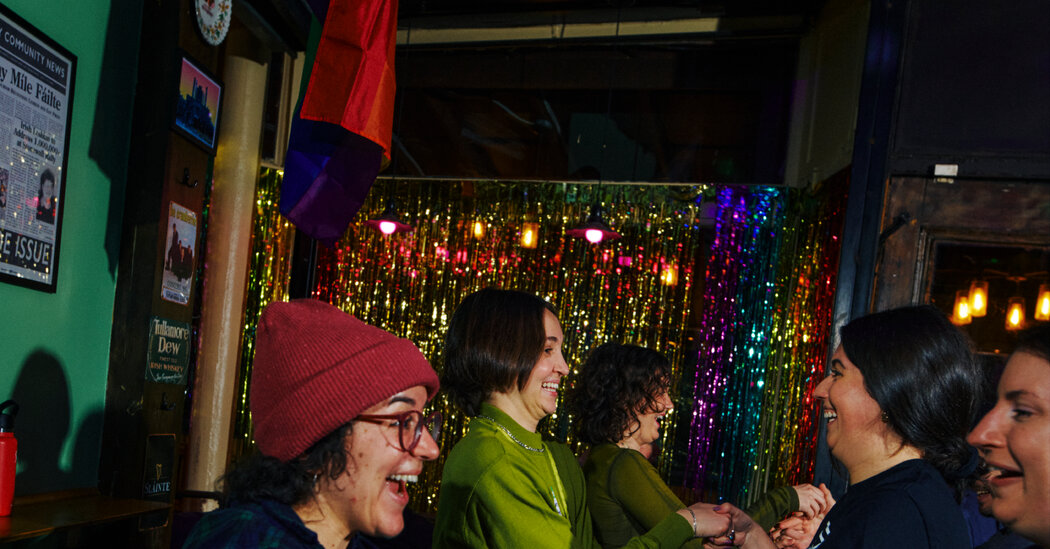Under the multicolored lights of a Brooklyn pub on a recent Monday night, a small crowd skipped and swung in circles, scrambling to keep up with the tempo of an Irish reel. Some were seasoned professionals; others were dipping a toe into Irish social dancing for the first time.
People came close to colliding as they advanced and retreated in rows of four, hands linked, or spun with partners in the tightly packed space. A formation that was supposed to resemble a square, with one couple stationed neatly on each side, wound up looking more like a wavy half-circle. Faces were flushed with confusion and joy.
In Irish dance, a form known for its upright posture and exacting rhythmic footwork — as well as its culture of high-pressure competition — precision is prized. But perfection is beside the point at Gayli, a series of L.G.B.T.Q.-friendly ceili classes in March at Mary’s Bar, a queer Irish pub on the border of Greenpoint and East Williamsburg. (The Irish word “ceili,” pronounced KAY-lee, refers to a social gathering with dance and music; Gayli is an affectionate play on words.)
“It’s pure chaos, in the best way possible,” said Rocco Lujan, a bartender at Mary’s who can be found bopping along to the music while pulling a pint. “It brings a lot of goodness to the space.”
Hosted by Brooklyn Irish Dance Company, a women-led troupe founded in 2018, Gayli is open to anyone who wants to join; picking up the steps is secondary to mingling and having a good time. At recent sessions, the demographic skewed young, the room full of people in their 20s and 30s who had answered the event flyer’s call: “All Levels & All Bodies Welcome!”
In a tradition with stringent rules and customs, including many that reinforce a gender binary, Gayli offers more than just fun. It offers a kind of freedom, an invitation to show up as your full self, that’s not always guaranteed in Irish dance, especially for L.G.B.T.Q. dancers.
“There’s absolutely no judgment of body, sexuality, gender, anything,” said KJ Campbell, 22, a transgender member of Brooklyn Irish Dance and a Gayli regular. “Everyone is here because they love to dance and hang out with other people.”
While traditional ceili dancing has clear-cut roles for “ladies” and “gents,” the hosts of Gayli use gender-neutral language as they teach and call out the steps. They might refer to the roles as “Xs and Os,” “the tall and the small” or “the one twirling and the one being twirled.”
Ceilis can be done socially or in Irish dance competitions, a tightly regulated world where dancers compete in categories for girls and boys, ladies and men, with corresponding expectations for costuming (far more elaborate for the ladies and girls). The Irish Dancing Commission, or An Coimisiun Le Rinci Gaelacha — the main governing body of competitive Irish dance — has an inclusive policy for transgender dancers, who may compete in the category consistent with their gender identity, although this position has not gone unchallenged.
The first Gayli, in October, came about when Brendan Donohoe, a co-owner of Mary’s, was looking to program more live events. A sister establishment to Ginger’s in Park Slope — a lesbian bar that’s been around for more than 20 years — Mary’s opened in April 2023 with the intention of embracing “what a pub really is meant to be: a public house, a house for the public,” said Donohoe.
Having grown up in Ireland at a time when he didn’t feel comfortable coming out — “the Catholic Church and all the rest of it,” he said — Donohoe also wanted to highlight the country’s progress on issues of L.G.B.T.Q. equality, like its referendum to legalize same-sex marriage in 2015. Mary’s is a celebration, he said, of “how far Ireland has come.”
Brooklyn Irish Dance had done some St. Patrick’s Day gigs at Ginger’s, where they proved popular, so Donohoe asked the dancers if they had ideas for an event at Mary’s. Alexandra Owensby — a founder of the company, along with Erin O’Donnell, Mallory Silliere and Stacey Cox — thought back to the monthly ceilis she had attended growing up in Portland, Ore.
“In high school we would choose to go Irish dance on a Friday night because we had that much fun,” she said. “I wanted to share that and create that space for my queer community.” (Outside of Brooklyn Irish Dance, Owensby performs in drag under the name Pete Zaparty.)
Not all Irish dancers have such positive ceili associations. Campbell trained at a demanding school in the Midwest, where his teachers made transphobic jokes and pressured him into maintaining a waiflike physique, he said. He grew up competing in the girls’ categories and, as a teenager, was part of two “senior ladies” teams in figure dancing (similar to ceili dancing) that won the world championships.
Those wins were “amazing accomplishments,” Campbell said, “but it was like dancing in a body that wasn’t yours, because it was senior ladies, and I have never felt like a lady.”
In solo dancing, too, Campbell found the gender conventions restrictive, especially when it came to the slip jig, a dance required only in the girls’ or ladies’ competitions. Known for its lilting grace, it didn’t appeal to Campbell. “I never want to do a slip jig again,” he said, laughing.
Gender in Irish dance has been in the public spotlight lately. In December, at the southern regional Irish dancing championships in Dallas, a 14-year-old transgender girl competed in the girls’ category and won, qualifying for the world championships. She faced a wave of ridicule online. A petition from a group called Concerned Irish Dance Teachers, Adjudicators, Parents and Dancers began to circulate, as did a counter-petition, led by the dancer Gabrielle Siegel, each gathering thousands of signatures. In response, the Irish Dancing Commission ruled that it would uphold its inclusive policy on transgender competitors.
“Seeing this, it only reinforced what’s important for us as a company,” said O’Donnell, a founder of Brooklyn Irish Dance who also runs her own school. “We’re trying to create a safe space not only for something like Gayli, but also in our main stage productions.”
Her students sometimes lead the way. While learning ceilis in class, she said: “They’re like, ‘Why? Why does it have to be a gent and a lady?’ And we’re like, ‘You know? It doesn’t. You’re right.’ These little Brooklyn kids are so much cooler than us.”
While Gayli appears to be the only Irish dance event of its kind in New York City, it’s part of a growing constellation of gender-inclusive folk dance gatherings around the world.
“Queer folk dance events have been on the rise for a long while,” Nic Gareiss, a dancer and dance researcher who studies traditional arts, said in an email, citing gender-neutral ceilis in Limerick, Ireland, and queer square dances hosted by the Detroit Square Dance Society. (There are also the line-dancing and two-stepping parties of Stud Country, which calls itself “The Queer Church of Line Dance,” in California and New York.)
In a phone conversation, Gareiss noted that L.G.B.T.Q. people have been Irish dancing for a long time but haven’t always been so visible or supported. “This is a moment where overt queer-affirming messages are being sent in Irish dance,” he said, “and that hasn’t historically been the case.”
At Gayli, those messages are drawing new people into an often insular world.
“Mostly what brought me here is a queer group of people and just having fun dancing,” said Kyra Miles, 23, who attended a recent session with friends. “None of us really know what we’re doing, so we’re basically goofing around and having a good time.”

